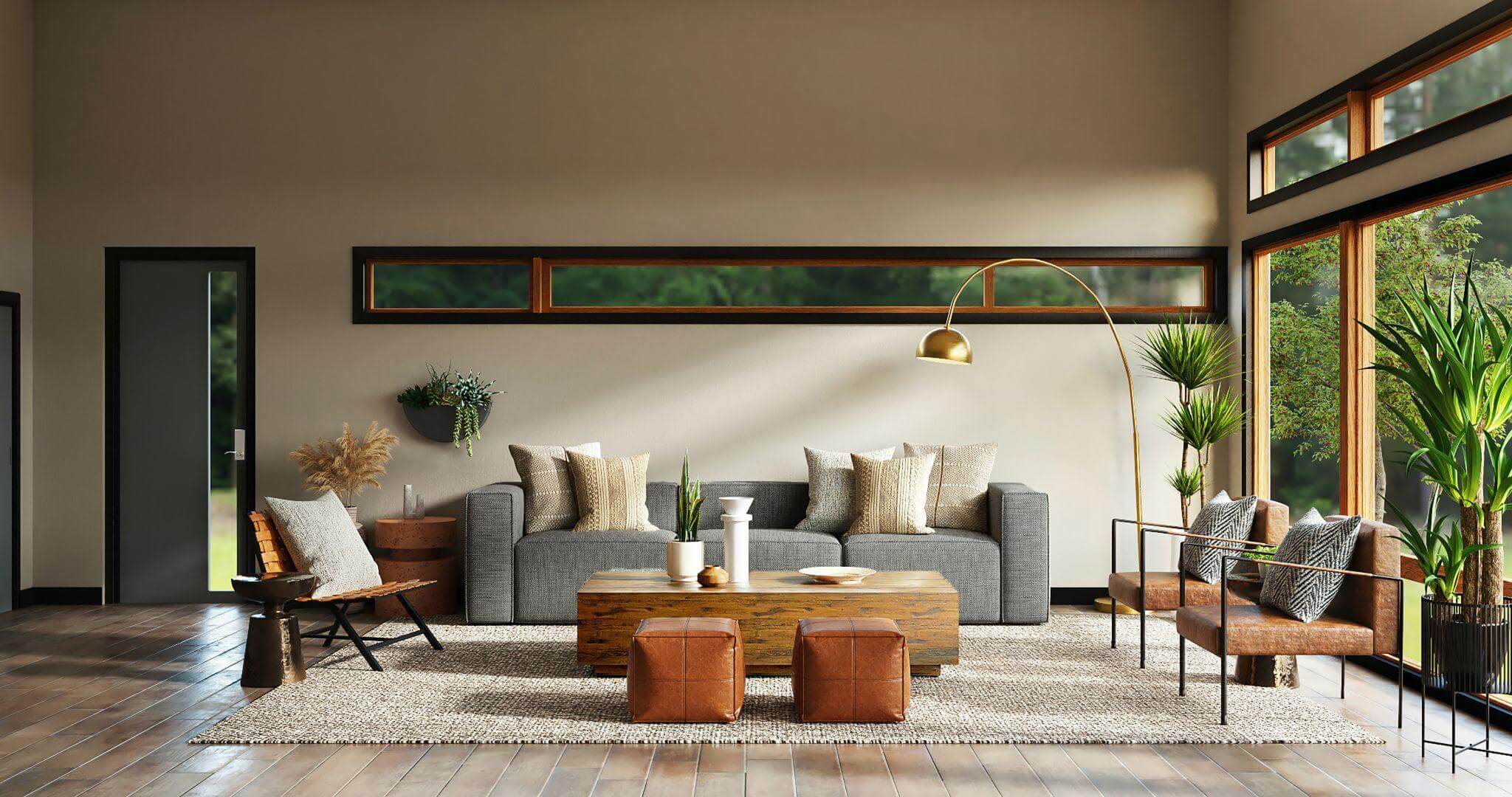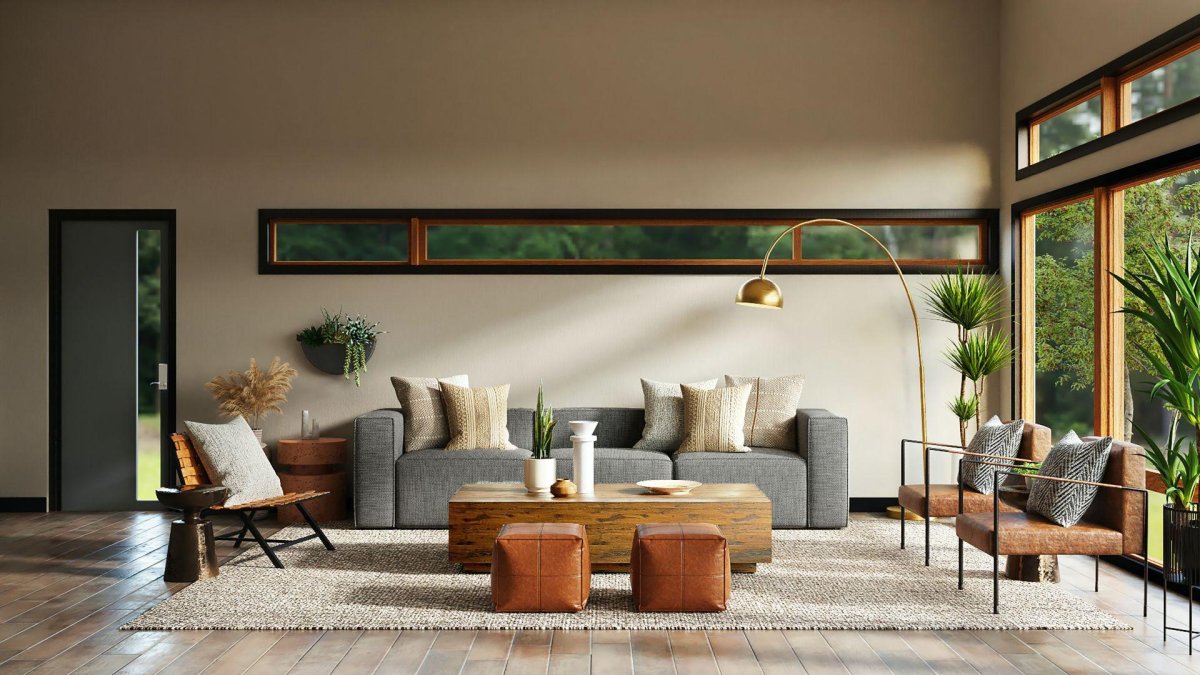
To create a stylish and comfortable living space, you’ll need to pay close attention to several design elements. From the choice of colours to the placement of furniture, this process requires careful consideration. Here are ten interior decorating tips to design your dream home that resonates with your personality and style…
1. Colour Palette
Begin your interior decorating by crafting a well-thought-out colour palette. Consider the emotions and vibes you want each room to evoke. Whether you’re aiming for tranquillity, vibrancy, or versatility, the colours you choose will play a vital role in creating the atmosphere you envision.
If you seek serenity and calmness, soft pastel shades can work wonders in evoking tranquillity. These gentle hues can create an oasis of relaxation, perfect for bedrooms or spaces dedicated to unwinding after a long day. On the other hand, if you want to inject energy and liveliness into your environment, bold and vibrant colours are ideal choices. Bright tones such as vivid yellows or vibrant blues can bring life to common areas like living rooms or dining spaces. These hues lend themselves well to creating an atmosphere full of enthusiasm and positive energy. For those who prefer versatility and adaptability in their design scheme, neutral tones provide endless possibilities. Shades of white, beige, taupe or grey offer a timeless elegance that can effortlessly blend with different styles and furniture pieces. This allows you to change up your decor without having to overhaul your entire colour scheme.
2. Layers & Textures
Elevate the sensory experience in your home by incorporating a variety of textures. From plush carpets and velvet cushions to woven throws, layering different textures adds depth and warmth. The tactile richness not only enhances comfort but also adds a touch of luxury to your interiors. Creating a visually and physically engaging space in your home can be achieved by incorporating layers and textures with a variety of materials, elevating the sensory experience and creating a more inviting atmosphere.
One way to achieve this is through the use of plush carpets. Not only do they provide comfort underfoot, but they also add an element of luxury to your interiors. Whether you opt for a deep pile or a softer texture, carpets offer warmth and softness that can enhance the overall feel of your space. Velvet cushions are another great addition to consider. The smooth and sumptuous texture of velvet adds an instant touch of sophistication to any room. Place them on sofas, chairs or beds for both visual appeal and extra comfort. Incorporating chunky knit blankets or waffle throws are yet another way to introduce texture into your home decor. Not only do they add warmth during colder months, but their intricate patterns also bring visual interest to any space. Whether draped over furniture or used as an extra layer on beds, these woven textures create depth while adding a cosy touch.
Also, consider mixing materials such as silk with linen or leather with wool for an even more diverse effect. By combining different textures throughout your interiors, you can create a multi-dimensional environment that is visually stimulating as well as comfortable.
3. Strategic Lighting
Lighting indeed plays a significant role in interior design, as it has the power to completely change the atmosphere of a space. To achieve versatility and enhance different aspects of your design, it is beneficial to incorporate three types of lighting: ambient, task, and accent.
Ambient lighting provides overall illumination and sets the tone for a room. It can be achieved through general ceiling lights or even natural light sources like windows or skylights.
Task lighting, on the other hand, focuses on specific areas where activities such as reading or cooking take place. This type of lighting should be brighter and more directed to ensure optimal visibility in those particular spaces.
Accent lighting adds depth and highlights specific elements within a room. It can be used to draw attention to artwork, architectural features, or any decorative items you want to showcase. Consider using statement pendant lights or chic chandeliers as focal points that not only provide functional light but also serve as eye-catching centrepieces.
Wall sconces are another excellent option for creating both ambient and accent lighting while saving valuable floor space. They can add an elegant touch while illuminating hallways or providing soft light beside mirrors.
Remember that experimenting with different combinations of these three types of lighting will allow you to create a layered effect that enhances your style and captures attention in all the right places.
4. Furniture
Furniture plays a crucial role in interior decorating as it not only provides functionality and comfort but also has the power to transform a space into a cohesive and aesthetically pleasing environment. The right choice of furniture can set the tone for a room, define its style, and create a visual impact. When selecting furniture, it is important to consider the overall design concept and the intended purpose of the space. Whether it’s a striking statement piece that catches the eye or a carefully selected ensemble that complements the room’s theme, the furniture acts as a foundation that ties the entire space together. Additionally, the materials, textures, and finishes of the furniture can play a role in the overall appeal of the room.
From metal coffee tables or a copper bathtub to a glass dining table or hanging egg chair, these statement pieces serve as conversation starters and focal points in your design scheme. For example, a bold, mid-century modern sofa not only becomes the focal point in a minimalist living room but also adds a touch of sophistication and character to the space.
By investing in high-quality and uniquely designed furniture, you can create a space that not only reflects your personal taste and style but also showcases your attention to detail and artistic vision. Selecting furniture that harmonises with the design concept and adds value to your space is crucial for creating a well-designed, inviting, and visually appealing environment.
5. Personal Touch
Personalising your home with artistic expression allows you to infuse your space with elements that reflect your personality and interests. One way to achieve this is by turning your walls into a canvas for self-expression. Consider creating a gallery wall of family photos to showcase cherished memories or frame artwork that resonates with you, whether it’s a painting by your favourite artist or a print of a beautiful landscape that holds special meaning.
Additionally, you can incorporate personalised decor elements throughout your home. For example, if you’re passionate about music, display a collection of vintage vinyl records or musical instruments as decorative pieces. If you have a love for travel, showcase globes, maps, or cultural artefacts that represent the destinations you’ve visited. These personal touches not only add character and charm but also create a space that truly feels like yours. Thoughtfully arrange and display these items in a way that tells a story and sparks conversations among your guests.
Personalising your home with these meaningful touches helps create a space that reflects your unique personality and passions, and ultimately makes your home yours.
6. Illusions of Space
Strategically placed mirrors can create the illusion of space and amplify natural light to enhance the aesthetics of any room. Experiment with decorative frames to add some glamour while serving a practical purpose.
For example, a large mirror in the entryway will reflect light and give the impression of a more expansive foyer. Consider using a variety of shapes and sizes to create visual interest, and don’t be afraid to experiment with unconventional placement. A well-positioned mirror can also act as a focal point, drawing attention to a particular area of the room. Additionally, mirrors can be used to reflect beautiful outdoor views or to complement existing decor. With careful consideration, mirrors can be a powerful tool in transforming the look and feel of your living space.
7. Bring the Outdoors In
Introduce an element of nature into your interiors with indoor plants. Beyond enhancing air quality, plants add a refreshing and vibrant element to your decor. Experiment with different planters to complement your interior style and create a seamless connection with the outdoors.
A collection of succulents in modern geometric planters can add a contemporary touch to the windowsill. Hanging plants can bring new dimensions to your space, while large leafy plants can act as statement pieces in any room. For a low-maintenance option, even artificial plants can offer a similar visual effect inside the home.
Remember, the presence of indoor plants not only enriches your surroundings but also contributes to a sense of well-being and tranquillity.
8. Functional Design
Make the most of your space by incorporating furniture that serves multiple functions. From storage ottomans to convertible sofa beds, functional design ensures your furniture is not only aesthetically pleasing but also practical for everyday living.
Furniture with hidden storage compartments is a great way to keep living spaces clutter-free. Opt for coffee tables with built-in shelves or drawers to stow away magazines, remote controls, and other items, keeping the tabletop free for drinks, board games or decor. Consider wall-mounted shelves or floating bookcases to display your favourite books, photographs, and decorative pieces while maximising floor space. Remember, versatile furniture not only adds character to your home but also enhances its functionality.
9. Flow and Layout
Consider the flow and layout of your space when arranging furniture. Create inviting conversation areas, and ensure pathways are clear. Thoughtful spatial arrangement enhances both functionality and aesthetic appeal. Experiment with different furniture configurations to find the most harmonious layout for your home.
It is important to create inviting conversation areas to encourage interaction and engagement among those in the space. This can be achieved by arranging seating in a way that facilitates face-to-face communication and by strategically placing focal points such as coffee tables or fireplaces.
Additionally, it is essential to ensure clear pathways throughout the room to avoid any hindrances or obstacles that may disrupt the functionality or aesthetic appeal of the space. Experimenting with different furniture configurations can help uncover the most suitable layout for the home. For example, arranging furniture in a circular formation in the living room can foster a sense of intimacy and closeness to encourage social interaction.
10. Finer details
Often overlooked, the choice of hardware can significantly impact the overall aesthetic of your space. Upgrading door handles, cabinet knobs, and faucets to stylish and cohesive designs can tie your entire interior together. Opt for finishes that complement your colour palette and style, such as brushed nickel, matte black, or antique brass. Consistent hardware choices create a sense of unity and elevate the finer details of your home, contributing to a more polished and cohesive design.
Remember, little details like matching handles, curtain rods, and light fixtures can also make a big impact. These small changes may seem insignificant, but they can elevate the overall look and feel of your home. You could replace dated cabinet handles in the kitchen with sleek, modern alternatives in a consistent finish to bring a subtle yet impactful change. By paying attention to these finer details, you can achieve a more unified aesthetic in your living areas.
Conclusion
With these ten interior decorating tips, your home will transform into a timeless masterpiece of enduring style and comfort. Each tip adds a unique touch to craft a space that not only showcases your personality but also stands the test of time. Embrace these timeless design principles and elevate your home to new heights.
Andres Walsh
Related posts
Stay connected
- How LoveOn Chat Is Becoming the Most Versatile AI Companion for Digital UsersThe internet keeps shifting toward hyper-personal interaction, and AI companions are at the center of this shift. What used to be simple chatbots are now evolving into emotionally aware, adaptive, and multi-functional digital partners. Among the new generation of platforms, LoveOn Chat is becoming one... The post How LoveOn Chat Is Becoming the Most Versatile […]

